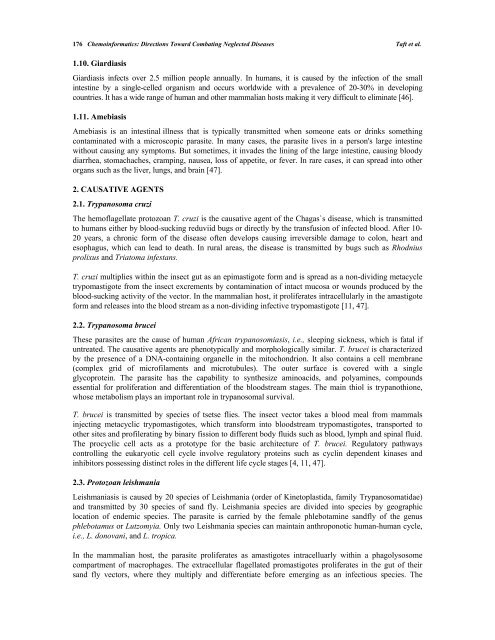chapter 1 - Bentham Science
chapter 1 - Bentham Science
chapter 1 - Bentham Science
Create successful ePaper yourself
Turn your PDF publications into a flip-book with our unique Google optimized e-Paper software.
176 Chemoinformatics: Directions Toward Combating Neglected Diseases Taft et al.<br />
1.10. Giardiasis<br />
Giardiasis infects over 2.5 million people annually. In humans, it is caused by the infection of the small<br />
intestine by a single-celled organism and occurs worldwide with a prevalence of 20-30% in developing<br />
countries. It has a wide range of human and other mammalian hosts making it very difficult to eliminate [46].<br />
1.11. Amebiasis<br />
Amebiasis is an intestinal illness that is typically transmitted when someone eats or drinks something<br />
contaminated with a microscopic parasite. In many cases, the parasite lives in a person's large intestine<br />
without causing any symptoms. But sometimes, it invades the lining of the large intestine, causing bloody<br />
diarrhea, stomachaches, cramping, nausea, loss of appetite, or fever. In rare cases, it can spread into other<br />
organs such as the liver, lungs, and brain [47].<br />
2. CAUSATIVE AGENTS<br />
2.1. Trypanosoma cruzi<br />
The hemoflagellate protozoan T. cruzi is the causative agent of the Chagas`s disease, which is transmitted<br />
to humans either by blood-sucking reduviid bugs or directly by the transfusion of infected blood. After 10-<br />
20 years, a chronic form of the disease often develops causing irreversible damage to colon, heart and<br />
esophagus, which can lead to death. In rural areas, the disease is transmitted by bugs such as Rhodnius<br />
prolixus and Triatoma infestans.<br />
T. cruzi multiplies within the insect gut as an epimastigote form and is spread as a non-dividing metacycle<br />
trypomastigote from the insect excrements by contamination of intact mucosa or wounds produced by the<br />
blood-sucking activity of the vector. In the mammalian host, it proliferates intracellularly in the amastigote<br />
form and releases into the blood stream as a non-dividing infective trypomastigote [11, 47].<br />
2.2. Trypanosoma brucei<br />
These parasites are the cause of human African trypanosomiasis, i.e., sleeping sickness, which is fatal if<br />
untreated. The causative agents are phenotypically and morphologically similar. T. brucei is characterized<br />
by the presence of a DNA-containing organelle in the mitochondrion. It also contains a cell membrane<br />
(complex grid of microfilaments and microtubules). The outer surface is covered with a single<br />
glycoprotein. The parasite has the capability to synthesize aminoacids, and polyamines, compounds<br />
essential for proliferation and differentiation of the bloodstream stages. The main thiol is trypanothione,<br />
whose metabolism plays an important role in trypanosomal survival.<br />
T. brucei is transmitted by species of tsetse flies. The insect vector takes a blood meal from mammals<br />
injecting metacyclic trypomastigotes, which transform into bloodstream trypomastigotes, transported to<br />
other sites and profilerating by binary fission to different body fluids such as blood, lymph and spinal fluid.<br />
The procyclic cell acts as a prototype for the basic architecture of T. brucei. Regulatory pathways<br />
controlling the eukaryotic cell cycle involve regulatory proteins such as cyclin dependent kinases and<br />
inhibitors possessing distinct roles in the different life cycle stages [4, 11, 47].<br />
2.3. Protozoan leishmania<br />
Leishmaniasis is caused by 20 species of Leishmania (order of Kinetoplastida, family Trypanosomatidae)<br />
and transmitted by 30 species of sand fly. Leishmania species are divided into species by geographic<br />
location of endemic species. The parasite is carried by the female phlebotamine sandfly of the genus<br />
phlebotamus or Lutzomyia. Only two Leishmania species can maintain anthroponotic human-human cycle,<br />
i.e., L. donovani, and L. tropica.<br />
In the mammalian host, the parasite proliferates as amastigotes intracelluarly within a phagolysosome<br />
compartment of macrophages. The extracellular flagellated promastigotes proliferates in the gut of their<br />
sand fly vectors, where they multiply and differentiate before emerging as an infectious species. The

















